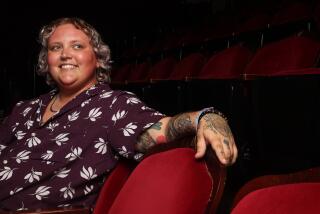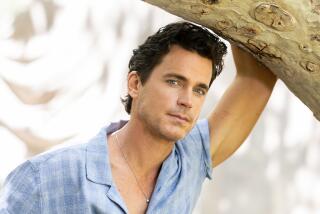No Tea & Sympathy for Them
From the first moments of “Queer as Folk,” it was clear this was not going to be an ordinary television drama series--even for British audiences used to lots of dicey language and sex on their network airwaves.
It’s 2 a.m., the last-chance hour on Canal Street, the gay district of Manchester, England, and the boys are out hunting for last-minute prey. The ruthlessly sexy, 29-year-old Stuart (Aidan Gillen) spots Nathan (Charlie Hunnam) under a street light. Young, scared, cocky and horny, Nathan’s a 15-year-old virgin on his first night out.
“Got somewhere to go?” Stuart coos at the teenager. “Wanna come back to mine?”
The graphic nude sex scenes that follow on “Queer as Folk,” which was broadcast last season on the U.K.’s Channel Four, were the first the British had seen on network television. “There’s something scary and shocking about the first episode,” says writer Russell T. Davies, “something quite ruthless and cold because it starts at 2 o’clock in the morning. None of us particularly want to see ourselves at 2 o’clock in the morning.”
But the shock and horror that colored the initial reaction to the series--much of it focused on Nathan’s sexual coming of age--largely dissipated. Audience numbers and critical acclaim began to grow as the series became less focused on its unprecedented depiction of gay sex and unfolded into a multilayered tale about Stuart and Vince (Craig Kelly), best friends on the verge of turning 30, and Nathan, “the one night stand that never went away.”
This unusual hybrid of comedy and drama evolved into far more than a chronicle of sexual escapades--ultimately it’s an examination of the lives of characters confronting age and mortality, parenthood and identity, love and loyalty. It’s easy for that to make “Queer as Folk” sound drenched with import. In truth, while there are serious issues underneath, with its unexpected mix of melodrama, razor-sharp humor and sheer whimsy, the series manages to evoke a kind of off-centered fun.
Besides causing a stir in Britain, a two-hour version of “Queer as Folk” was broadcast recently in France, and several European countries have bought the series. The buzz the show picked up on the gay film festival circuit in the U.S. led producer Nicola Shindler and Channel Four into conversations with HBO about co-producing an American remake. HBO dropped out after a sticking point on format--whether it was more suited to a series or a movie, with Channel Four wanting the former, HBO the latter--and now Showtime has initiated serious talks about turning it into a series here.
Whatever shape the U.S. television deal takes, it is unlikely that anything resembling the original--with its raw sexual content and explicit language--will air in this country, even in the era of “Sex and the City” and “The Sopranos.”
The scene that proved heart-stopping and the most controversial during the initial British run would doubtless never make it into a U.S. translation: the vivid depiction of a 15-year-old boy losing his virginity to a man twice his age. Nor would even a spot on cable be likely to accommodate the extravagant use of graphic language, the drugs snorted in nightclub bathrooms, the spontaneous sex without a condom in sight.
Hopefully any adaptation would attempt to re-create the frank, witty, intelligent, absorbingly told stories--the qualities that ultimately turned “Queer as Folk” into such a television phenomenon in its home country--in which the main characters are neither apologists nor role models, victims of AIDS or homophobic violence; nor the cuddly, nonthreateningly asexual confidants of straight women.
Davies, 35, who would serve as a consultant on any U.S. adaptation, says he spent years writing token homosexual characters for British TV. “I worked on a soap opera where someone said, ‘I’ve got a great idea for a character--he’s gay!’ and the next thing out of his mouth was, ‘And he’s got AIDS.’ A lot of gay drama is written like that, all very safe and very representative,” he says.
Davies credits Shindler, whose Manchester-based Red production company made the series for Britain’s Channel Four, with giving him permission to create a universe where the token characters were straight and every nuance of gay culture didn’t have to be explained.
“Nicola said, ‘Don’t be anthropological,’ ” Davies explains. “If the story’s working, people will understand. She gave me the freedom to write however I wanted. Usually you have 10 executive producers standing over your shoulders making sure it’s safe and bland. [If] you don’t have to bother with boring, mainstream morality, you can get closer to something like a real morality. We all know people who do drugs and sleep around.”
While “Queer as Folk” isn’t an issues-based series, it is told against the backdrop of homophobia, AIDS and other stark realities of gay life. Early in the series, one of the trio’s friends takes a guy home with him and, out of a nervous desire to please him, joins him in an out-of-character snort of something that kills him. “That’s not [necessarily] a drug story,” Davies insists. “It could be an HIV story--any unsafe night in which you’re not in control of what you’re doing in your own house.”
That’s as dark as “Queer as Folk” gets. In one very funny scene, a potential lover admits to Vince in mid-kiss that he has been treated for Brazilian parasites, which quickly chills their vigorous foreplay. Perhaps one of the most surprising things about the series is how Davies manages to infuse humor into many otherwise dark corners.
Charles McDougall, who directed the first four episodes, says that he worked hard to create a visual style that matched the fast-paced wit of the script. He gave the gritty streets of Manchester a glossy topcoat and added an infectious, upbeat soundtrack.
“People thought it might be seedy, this world we’re showing,” says McDougall, 36. “As great a fear as being thought to be seedy was being thought to be serious. It’s meant to be very light and funny and sexy.”
When “Queer as Folk” (both a G-rated wordplay of an unprintable expression and part of an old Yorkshire saying: “There’s nowt so queer as folk,” meaning, basically, people are strange) premiered in the U.K. last February, the conservative press called it sensational and pornographic; some gay-rights groups felt the characters--particularly the arrogantly self-absorbed Stuart, with his strident vanity and hedonistic appetites--reinforced dangerous stereotypes.
References to the show began to show up in gossip columns and cartoons, and op-ed writers used Nathan’s deflowering to discuss the parliamentary debate about lowering the age of consent for gay sex from 18 to 16 (the legal age for straight males). Though Davies points out that no one seems to be bothered by Stuart’s monologue about his first sexual experience--with his seventh-grade gym teacher. “I’ve had no complaints about that!” Davies says incredulously. ‘People are so scared of nakedness and sex. It just goes to show the power of an image over the word.”
*
“Queer as Folk” has attracted as many fans than critics, and in the process it turned into one of the most talked about shows in recent memory.. Some 2 million viewers tuned in, the network’s second-highest rating next to “ER,” and more than half the audience was female. Videos and a CD of the soundtrack have sold briskly. Surprisingly, the lead actors get the bulk of their fan mail from young girls. Director McDougall insists that it is sheer coincidence that he and the lead actors are not gay. Those who auditioned were given advance copies of the script, so they knew what they were getting into.
And he asked them point-blank if they’d mind taking their clothes off and “having simulated sex with boys. A lot of men love the idea of playing a killer,” he says, but shied away from playing a gay man.
Hunnam, 19, says that he was initially worried about playing the role authentically. “But what is convincingly gay?” he asks. “There are the stereotyped, cliched ideas, but those are the kind of cliched ideas we wanted to keep away from.” He admits that he found the sex scenes “a little bit difficult to do.” When he is told that he did a convincing job, he grins. “Yeah, you’re not wrong. I watched it with my friends and they were like: ‘Oh, my God.’ ”
McDougall admits he was worried about making the series credible for a gay audience that knows the subject matter more intimately than he does. “I didn’t know if we’d all look stupid,” McDougall concedes, “and as importantly, I didn’t know whether gay people and the gay community in Manchester in particular would think we’d sold them out.”
In July, when the series was screened at Outfest, Los Angeles’ annual gay and lesbian film festival, almost all of the 600 mostly gay men stayed in their seats--laughing, cheering and clapping along to the catchy theme tune--for the 4 1/2 hours of back-to-back episodes.
McDougall, who along with co-director Sarah Harding was in L.A. for the screening, says he is thrilled that “Queer as Folk” went over so well despite the regional British accents and the local references.
“It showed if you make something true to itself, people can respond to it, it will have a universality,” he says. “That’s what I went for--as wide an audience as possible.”
Davies says now that it looks like “Queer as Folk” will have a second life under someone else’s hand in the U.S., he is focusing on his next project. Titled “Misfits” and still waiting for network approval, he envisions it having “the same energy and reality” as “Queer as Folk” but with “a mix of gay and straight characters.” It would center on one of the supporting characters introduced in “Queer as Folk”--Vince’s 45-year-old mother, Hazel, who runs one of the gay clubs in the show. Targeted for fall of 2000, the series also would develop two other minor characters from the original: Alexander, the campiest of the characters, and Bernard, a lovable, cynical veteran of the gay scene.
The final chapter for Stuart, Vince and Nathan, though, has been written. The cast and crew recently wrapped a two-part sequel, which will be broadcast in February.
“Loads of people are going to hate the ending,” says Davies with a smile in his voice. “It won’t be what people expect--it won’t be nice and comfortable for them. A lot of people have made heroes of [the trio] and bonded with them, and some things the characters do will test your faith in them because nobody should be that easy to love.”
Besides, says Davies, he “didn’t want ‘Queer as Folk’ to turn into a soap opera. “I mean, how many times can they go out clubbing, how many times can they have a one-night stand? Every good story has an ending.”
More to Read
The complete guide to home viewing
Get Screen Gab for everything about the TV shows and streaming movies everyone’s talking about.
You may occasionally receive promotional content from the Los Angeles Times.






